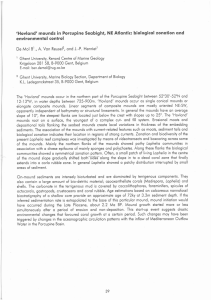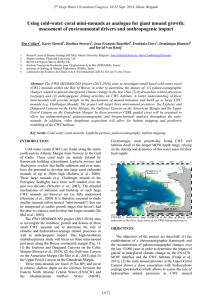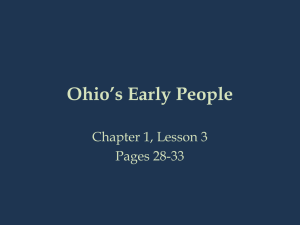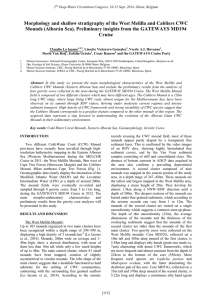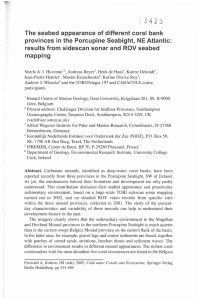Buried cold-water coral mound provinces and contourite drifts along the
advertisement
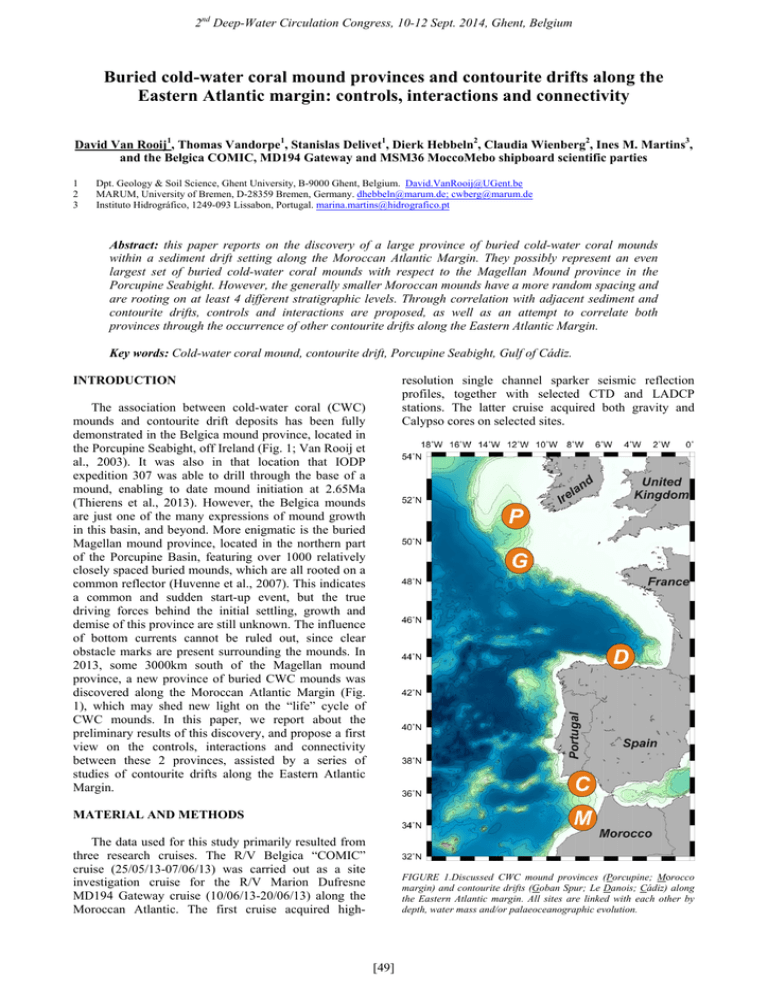
2nd Deep-Water Circulation Congress, 10-12 Sept. 2014, Ghent, Belgium Buried cold-water coral mound provinces and contourite drifts along the Eastern Atlantic margin: controls, interactions and connectivity David Van Rooij1, Thomas Vandorpe1, Stanislas Delivet1, Dierk Hebbeln2, Claudia Wienberg2, Ines M. Martins3, and the Belgica COMIC, MD194 Gateway and MSM36 MoccoMebo shipboard scientific parties 1 2 3 Dpt. Geology & Soil Science, Ghent University, B-9000 Ghent, Belgium. David.VanRooij@UGent.be MARUM, University of Bremen, D-28359 Bremen, Germany. dhebbeln@marum.de; cwberg@marum.de Instituto Hidrográfico, 1249-093 Lissabon, Portugal. marina.martins@hidrografico.pt Abstract: this paper reports on the discovery of a large province of buried cold-water coral mounds within a sediment drift setting along the Moroccan Atlantic Margin. They possibly represent an even largest set of buried cold-water coral mounds with respect to the Magellan Mound province in the Porcupine Seabight. However, the generally smaller Moroccan mounds have a more random spacing and are rooting on at least 4 different stratigraphic levels. Through correlation with adjacent sediment and contourite drifts, controls and interactions are proposed, as well as an attempt to correlate both provinces through the occurrence of other contourite drifts along the Eastern Atlantic Margin. Key words: Cold-water coral mound, contourite drift, Porcupine Seabight, Gulf of Cádiz. resolution single channel sparker seismic reflection profiles, together with selected CTD and LADCP stations. The latter cruise acquired both gravity and Calypso cores on selected sites. INTRODUCTION The association between cold-water coral (CWC) mounds and contourite drift deposits has been fully demonstrated in the Belgica mound province, located in the Porcupine Seabight, off Ireland (Fig. 1; Van Rooij et al., 2003). It was also in that location that IODP expedition 307 was able to drill through the base of a mound, enabling to date mound initiation at 2.65Ma (Thierens et al., 2013). However, the Belgica mounds are just one of the many expressions of mound growth in this basin, and beyond. More enigmatic is the buried Magellan mound province, located in the northern part of the Porcupine Basin, featuring over 1000 relatively closely spaced buried mounds, which are all rooted on a common reflector (Huvenne et al., 2007). This indicates a common and sudden start-up event, but the true driving forces behind the initial settling, growth and demise of this province are still unknown. The influence of bottom currents cannot be ruled out, since clear obstacle marks are present surrounding the mounds. In 2013, some 3000km south of the Magellan mound province, a new province of buried CWC mounds was discovered along the Moroccan Atlantic Margin (Fig. 1), which may shed new light on the “life” cycle of CWC mounds. In this paper, we report about the preliminary results of this discovery, and propose a first view on the controls, interactions and connectivity between these 2 provinces, assisted by a series of studies of contourite drifts along the Eastern Atlantic Margin. MATERIAL AND METHODS The data used for this study primarily resulted from three research cruises. The R/V Belgica “COMIC” cruise (25/05/13-07/06/13) was carried out as a site investigation cruise for the R/V Marion Dufresne MD194 Gateway cruise (10/06/13-20/06/13) along the Moroccan Atlantic. The first cruise acquired high- FIGURE 1.Discussed CWC mound provinces (Porcupine; Morocco margin) and contourite drifts (Goban Spur; Le Danois; Cádiz) along the Eastern Atlantic margin. All sites are linked with each other by depth, water mass and/or palaeoceanographic evolution. [49] 2nd Deep-Water Circulation Congress, 10-12 Sept. 2014, Ghent, Belgium Finally, the MSM36 “MoccoMeBo” expedition on board R/V Maria S. Merian (18/02/14-17/03/14) revisited identical sites (among others), visualizing them in very high-resolution using the shipboard PARASOUND subbottom profiler. ACKNOWLEDGEMENTS The authors acknowledge the captains and crews of RV Belgica COMIC, MD194 Gateway and MSM36 MoccoMebo. This study was funded through research grants of Ghent University BOF and the Flemish FWO. DISCUSSION AND CONCLUSIONS REFERENCES The newly discovered buried CWC mounds can be associated to a vast province of several clusters of seabed mounds (Fig. 2), reported by Hebbeln et al. (2008). They occur in water depths between 500 and 1000 m, buried under up to 50 m of sediment. With respect to the Magellan mounds, they are smaller, but more importantly, they do not root on one single stratigraphic level. At least 4 different initiation levels were identified. The off-mound reflectors indicate a slight influence of bottom currents, since the mounds are located in a large sediment drift that is related to the Pen Duick CDS, for which a seismic stratigraphy has been proposed by Vandorpe et al. (2014). Hebbeln, D. et al., 2008. Report and preliminary results of RV Pelagia cruise 64PE284 “Cold-water Corals in the Gulf of Cádiz and on Coral Patch Seamount (NE Atlantic)”. Berichte, Fachbereich Geowissenschaften 265. Universität Bremen, Bremen, p. 64. Huvenne, V.A.I., Bailey, W.R., Shannon, P.M., Naeth, J., di Primio, R., Henriet, J.-P., Horsfield, B., de Haas, H., Wheeler, A.J., Olu-Le Roy, K., 2007. The Magellan mound province in the Porcupine Basin. International Journal of Earth Sciences 96, 85-101. Thierens, M., Browning, E., Pirlet, H., Loutre, M.F., Dorschel, B., Huvenne, V.A.I., Titschack, J., Colin, C., Foubert, A., Wheeler, A.J., 2013. Cold-water coral carbonate mounds as unique palaeo-archives: the Plio-Pleistocene Challenger Mound record (NE Atlantic). Quaternary Science Reviews 73, 14-30. Vandorpe, T., Van Rooij, D., de Haas, H., 2014. Stratigraphy and paleoceanography of a topographycontrolled contourite drift in the Pen Duick area, southern Gulf of Cádiz. Marine Geology 349, 136151. Van Rooij, D., De Mol, B., Huvenne, V., Ivanov, M.K., Henriet, J.-P., 2003. Seismic evidence of currentcontrolled sedimentation in the Belgica mound province, upper Porcupine slope, southwest of Ireland. Marine Geology 195, 31-53. Moreover, the link between the two buried mound provinces may be found in connecting the evolution of the associated contourite drift systems, respectively in Porcupine Seabight and the Gulf of Cádiz. Intermediate sites on Goban Spur and near Le Danois Bank have enabled to correlate stratigraphic events over such large distances, mainly driven by changes in the Mediterranean Outflow Water (MOW). However, Vandorpe et al. (2014), clearly pointed out the influence of the Antarctic Intermediate Water (AAIW) on the Moroccan Margin, but that a correlation with the Cádiz CDS is feasible, suggesting a linkage between MOW and AAIW dynamics in the southern Gulf of Cádiz. FIGURE 2. RCMG high-resolution reflection seismic profile (sparker) through the seabed and buried CWC mound along the Moroccan Atlantic Margin. Note the 4 different levels on which all mounds root, as well as their association with a recently active fault system. The surface of the seabed mounds are notably influenced by bottom current flow around an obstacle. [50]

